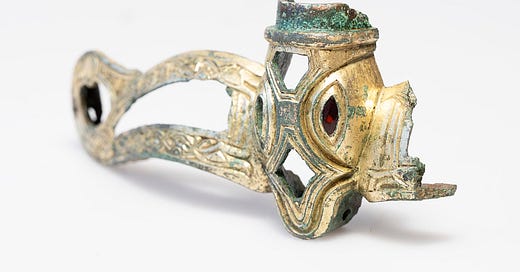The Lejre Helmet Fragment – A Rare Glimpse into Pre-Viking Age Royalty
Archaeologists have uncovered fragments of a rare pre-Viking Age helmet at Lejre, Denmark. This finding strengthens the idea that Lejre was a center of power before and during the Viking Age. Helmets from this period are rare, making this discovery significant for understanding warfare and the status of elite warriors.
The find was announced by ROMU, the museum organization overseeing the excavation. According to the official press release, the helmet confirms Lejre’s historical importance. “This is an archaeological sensation,” says ROMU’s head of research, Tom Christensen. “It cements Lejre’s role as a seat of power and gives us new insight into the warrior aristocracy of the pre-Viking Age.”
Unearthing the Past: The Lejre Helmet Fragments
The fragments were found at Lejre, a site linked to the legendary Skjöldung dynasty. Archaeologists have uncovered massive hall complexes here, believed to be royal residences. This helmet adds to the growing evidence that Lejre was home to important rulers.
The helmet is being studied to determine its full shape and design. While only fragments remain, early analysis suggests it was high-status armor. It may share features with the Gjermundbu helmet, the only Viking helmet ever found in Scandinavia (albeit a fragment as well).
Helmets in the Viking World: A Rare and Prestigious Item
Viking helmets are rare in the archaeological record. Unlike swords, which have been found in large numbers, helmets were not common grave goods. Metal was valuable and often reused. Helmets may have been reserved for the elite, making this find even more significant.
In my previous article, "Did the Vikings Wear Helmets? Revisited," I examined the lack of Viking helmets in the archaeological record. This discovery supports the idea that helmets were symbols of power rather than standard battle gear even before the Viking Age began.
Lejre: A Seat of Royalty
Lejre has long been considered a royal power center. Some believe it inspired the Beowulf legend’s Heorot Hall. Over the years, excavations have uncovered weapons, treasures, and monumental halls. This helmet adds to the picture of Lejre as a seat of leadership before and perhaps during the Viking Age.
If the helmet belonged to a noble or king, it provides physical evidence of military leadership. It may help historians understand how rulers armed themselves and displayed their status in pre-Viking Age Scandinavia.
What’s Next for the Lejre Helmet?
Researchers are analyzing the fragments to learn more about the helmet’s design and construction. There is hope that enough remains for a partial reconstruction. The helmet will be displayed at a Danish museum.
Conclusion: A Monumental Find in Viking Archaeology
The Lejre helmet confirms the site’s role as a power center. It provides rare physical evidence of elite armor. This discovery challenges assumptions about pre-Viking Age warfare and leadership.
For a deeper look at Viking helmets and their rarity, read my article, "Did the Vikings Wear Helmets? Revisited." With each new find, the Viking Age becomes clearer. The Lejre helmet is another step toward understanding the warriors who shaped history.
Don’t forget to buy my books!






